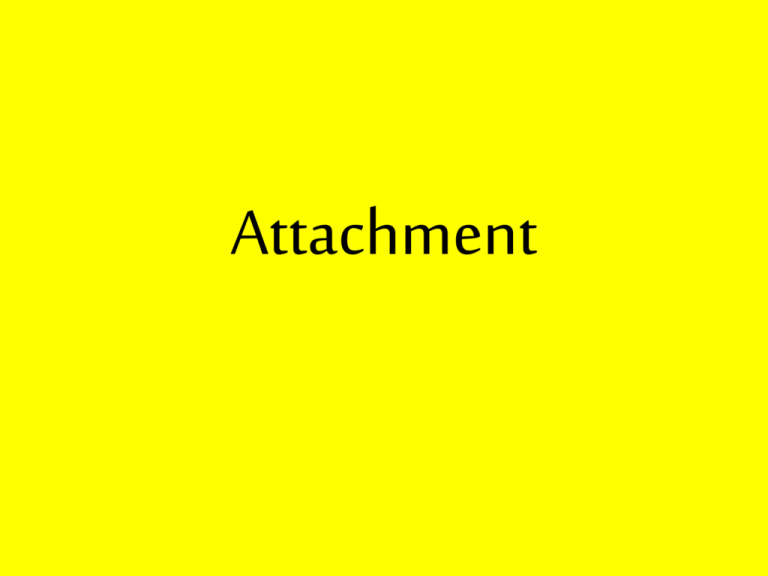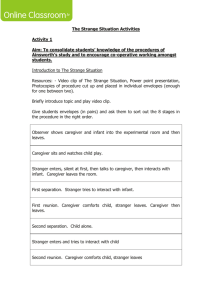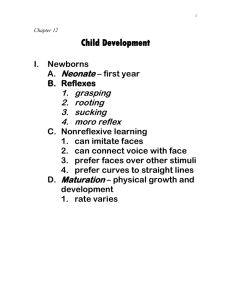Emotional development Bowlby and Ainsworth
advertisement

Attachment By the end of the lesson • Attachment • • Attachment target • • 2 purposes of forming • attachment • • Secure base • Proximity maintenance • • Separation distress • Safe Haven Resistant attachment Avoidant attachment Secure attachment Characteristics of the adult to aid attachment Characteristics of the infant to aid attachment Attachment the tendency of infants to form an emotional bond to another person, usually their main caregiver. Attachment target • is the person(s) to whom an infant forms an attachment. The infant will seek attention from and contact with the attachment target more than they do with any other person. Why go to the trouble of forming an attachment? • Bowlby considered the infant–caregiver bond to be important in two ways. • First, the bond forms the foundation for healthy emotional development later in life. • Second, the bond has an ‘evolutionary’ function, which, according to Bowlby, improves the infant’s chances of survival. A close emotional connection with a caregiver keeps the infant and caregiver physically close, thereby increasing the helpless and dependent infant’s chances of survival. Who do they attach to? • Bowlby proposed that infants form attachments with those people most closely involved with them. This is usually the main caregiver, most commonly the mother. • Many infants develop strong attachments to both parents. • However, it is not uncommon for an infant to have a stronger attachment to the mother than the father, or vice versa. Infants are also capable of developing different and separate attachments with other people who have significant involvement in their lives; for example, an older sibling, a grandparent or childcare worker. Do you think that attachment would change over time? Time frame • Generally, infants under six months of age do not fully recognise their caregivers on an individual basis. • From about two months of age, infants may show some signs of identifying individual caregivers. For example, an infant may start to show negative reactions when their main caregiver leaves or turns their attention elsewhere. However, at this age, nearly anyone who provides the desired comfort or attention will quickly be accepted as a substitute. Time frame • Between about six and eight months of age there is usually a change from the earlier pattern of accepting comfort from just about anyone. This period marks the development of a special attachment to the main caregiver, usually the mother. Infants are likely to cry and cling when their main caregiver moves away from them and to react negatively to anyone else who tries to comfort them. Should it be women only that stay home and take care of the children? Do mothers actually make better caregivers? One of Bowlby’s views on attachment which caused a great deal of controversy is that mothers are the best care givers for infants. He believed ‘nature’ intended the mother to be the primary or main caregiver. In other words, Bowlby believed females are genetically programmed to be the best and therefore the main caregiver. Attachment objects • For many children, their ‘blankie’, ‘bibba’, ‘num num’, or ‘teddy’ are as important in their daily lives as their main caregiver. • In fact, there are many parents who dread the thought of going anywhere with their child without the loved ‘security blanket’. • The term security blanket usually refers in a general way to inanimate (‘non-living’) objects like a blanket, a special bib, a dummy, a teddy bear or another soft toy for which the child has a special affection. For most children, however, the security blanket does not usually replace the attachment to the main caregiver. It provides an additional attachment, which, unlike the caregiver, can be taken with the child wherever they go. • Most attachments to security blankets develop between about 10 and 12 months of age and they serve an important function of comforting a child when separated from the main caregiver; for example, when a child goes to bed or is left in the care of a person who is not the main caregiver. • A security blanket is also often the first thing children ask for when they are upset or afraid. It seems to provide reassurance and comfort in mildly stressful situations. How will we know if an infant is attached to their caregiver? • Proximity maintenance -the infant’s desire to be near the person(s) to whom it is attached • Safe haven-the ability to return to the attachment figure for comfort and safety when scared or feeling unsafe or threatened • Secure base- the ability to perceive the attachment figure as a base of security from which the infant can explore the surrounding environment • Separation distress- anxiety experienced when the attachment figure leaves or is absent. Design a way to test each of these: • • • • Proximity maintenance Safe haven Secure base Separation anxiety Ainsworth’s theory • Ainsworth (1978), behaviours that indicate attachment include: • crying to attract the caregiver’s attention • crying when held by someone other than the caregiver and stopping when taken by the caregiver • clinging physically to the caregiver, particularly in the presence of a stranger • smiling at the caregiver more readily and more frequently than at other people • vocalising (making sounds) more readily and more frequently in the caregiver’s presence than when with strangers • looking at the caregiver when separated but in sight • crying when the caregiver can no longer be seen • climbing over the caregiver, exploring and playing with the caregiver’s face, hair and clothes • greeting the caregiver after an absence by raising arms, smiling and making sounds • lifting arms to be picked up by the caregiver • embracing, hugging, kissing the caregiver • burying their face in the caregiver’s lap • when able to crawl, following the caregiver when they leave and approaching them on their return • exploring the environment using the caregiver as a secure ‘home’ base, returning from time to time for brief periods. Ainsworth came up with different types of attachment Secure attachment An infant who has formed a secure attachment shows a balance between dependence and exploration. The infant uses the caregiver as a ‘home’, or safe base from which to venture out and explore an unfamiliar environment, but shows some distress and decreases exploration when the caregiver departs. When the caregiver returns, the infant is enthusiastic and seeks physical contact with them. Securely attached infants feel safe and are able to depend on their care givers. The infant’s moderate distress at their caregiver’s departure suggests that they feel confident that the care giver will return. About 65% of one-year-olds are securely attached. Avoidant attachment The infant does not seek closeness or contact with the caregiver and treats them much like a stranger. The infant rarely cries when the caregiver leaves the room and ignores the caregiver upon their return. Research findings suggest that this attachment style may be the result of neglectful or abusive caregivers. About 20% of one-year-olds are in this category. Resistant attachment • The infant appears anxious even when their caregiver is near. They become very upset when separated from the caregiver. When the caregiver returns, the infant approaches them, cries to be picked up, then squirms or fights to get free, as though it is not sure about what it really wants. This attachment style is thought to result from caregivers who are not very responsive to their infant’s needs. It is assumed the infant feels they cannot depend on their caregiver to be available to them if needed. About 12% of one-year-olds are in this category. Ainsworth(1982) found that the patterns of behaviour associated with each type of attachment tend not to change over time unless there are significant changes in life circumstances for either the caregiver or the infant. However, she believed the nature of the attachment may change if the caregiver substantially changes the way in which they interact with the infant, particularly the way in which they respond to the infant’s expressed needs. • You have been invited to give a talk to the local mother and baby group. Using ideas from Bowlby’s theory of attachment, what advice might you give the mothers about how they could form a strong mother-child bond? • Bowlby said that an infant must form an attachment to one main caregiver, usually the mother. Care needs to be consistent, meaning that she needs to ensure that she does not do anything to disrupt the attachment, for example by leaving the child in the care of someone else. The mother also has to give responsive and sensitive care for a successful attachment to develop. This means that the mother needs to respond appropriately to social releasers.








